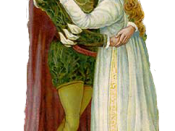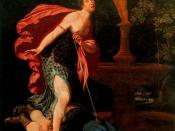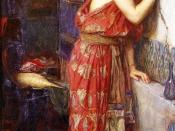Ben Weissler
8/15/07
The origins of Shakespeare's play "Romeo and Juliet" are relatively unknown. It's hard to believe, but this archetypal theme of ill-fated love predates Shakespeare by more than a thousand years. The Merriam-Webster dictionary defines "archetype" as: the original pattern or model of which all things of the same type are representations or copies. One of the first pieces of written work to include this common archetype of ill-fated love was Ovid's "Pyramus and Thisbe." Written around A.D eight, and published in Ovid's Metamorphoses, this poem recounts the story of two forbidden lovers who come to a tragic end, a theme recurring in literature. Shakespeare and Ovid both employ similar and different archetypal symbols within their work.
One common archetypal symbol in both Ovid and Shakespeare's work is the wall, symbolizing forbidden love. Ovid gives life to the wall by describing it as "hateful," thus personifying the wall.
Another example of how Ovid makes the wall more than just a inanimate barrier between the two lovers is when the lovers speak to wall. A most memorable line was when Pyramus and Thisbe declared, "But for you we could touch, kiss," addressing the wall as a person. In comparison, in "Romeo and Juliet" the "wall" was the Montagues and Capulets fierce hatred for one another. In "A Midsummer's Night Dream", Shakespeare further develops this symbol of forbidden love by casting the wall as a character played by a person. This transforms the wall into more than just an inanimate object, but as an actual living thing that is separating the two lovers. Shakespeare and Ovid employ different means of personifying the wall, but in both, the wall is represented as a symbol of forbidden love.
Another powerful archetypal symbol in "Pyramus and Thisbe" is the mulberry tree. Ovid uses the mulberry tree as a symbol of death and the ill-fated love of Pyramus and Thisbe. Ovid's poem starts out with a description of the mulberry tree, informing the reader that once upon a time the red berries of the mulberry tree were actually as white as snow. Like all of the other tales in Ovid's Metamorphoses, this poem is focused around change, in this particular case, the change in color of the berries of the mulberry tree. Ovid tells us that the berries were stained red by the blood of Pyramus as he committed suicide upon finding Thisbe's blood-stained cloak. Another archetypal symbol of death, similar to the mulberry tree, is the lion used by Ovid, the harbinger of death. In fact one can view death itself as another "wall" that separates Pyramus from Thisbe, until she joins him in death. Archetypal symbols of death, such as the mulberry tree and the lion, appear in numerous works of literature, and can be identified in Shakespeare's plays.
Up until this point, I have been analyzing Ovid's and Shakespeare's use of archetypal symbols, but it is also important to point out some similarities and differences between both authors. "Romeo and Juliet" and "A Midsummer's Night Dream" both incorporate elements from "Pyramus and Thisbe". However, the parallels between"Romeo and Juliet" and "Pyramus and Thisbe" are more authentic, given that "A Midsummer's Night Dream" is Shakespeare's satire of "Romeo and Juliet"and "Pyramus and Thisbe." Both "Romeo and Juliet" "Pyramus and Thisbe" have parallel plots, common symbols, and archetypal characters. On the other hand, the original "Pyramus and Thisbe" is somewhat similar to the amusing rendition that the characters of "Pyramus and Thisbe" that Bottom and his friends from "A Midsummer's Night Dream" perform. However, there are some differences. In "A Midsummer's Night Dream" Ovid's work is performed crudely and absurdly, meaning that Shakespeare was well aware of these oft-repeated symbols and themes and wished to parody them.
Next time I read a piece of literature, I will have my eyes open for some of the archetypal symbols the Ovid and Shakespeare use in their work. Being able to recognize archetypal themes and symbols gives the reader a profound and more meaningful understanding of the text. Both Ovid, in "Pyramus and Thisbe", and Shakespeare, in "Romeo and Juliet" and "A Midsummer's Night Dream," employ common archetypal symbols as a way to enhance the story that they are telling.
Works Consulted:
Hosley, Richard (1965). Romeo and Juliet. New Haven: Yale University Press.
Roberts, Arthur J. (1902). "The Sources of Romeo and Juliet". Modern Language Notes



Too colloquial.
Please be a tad more formal.
0 out of 0 people found this comment useful.